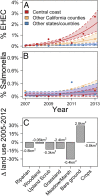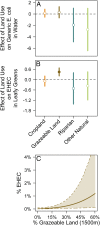Comanaging fresh produce for nature conservation and food safety
- PMID: 26261343
- PMCID: PMC4568220
- DOI: 10.1073/pnas.1508435112
Comanaging fresh produce for nature conservation and food safety
Abstract
In 2006, a deadly Escherichia coli O157:H7 outbreak in bagged spinach was traced to California's Central Coast region, where >70% of the salad vegetables sold in the United States are produced. Although no definitive cause for the outbreak could be determined, wildlife was implicated as a disease vector. Growers were subsequently pressured to minimize the intrusion of wildlife onto their farm fields by removing surrounding noncrop vegetation. How vegetation removal actually affects foodborne pathogens remains unknown, however. We combined a fine-scale land use map with three datasets comprising ∼250,000 enterohemorrhagic E. coli (EHEC), generic E. coli, and Salmonella tests in produce, irrigation water, and rodents to quantify whether seminatural vegetation surrounding farmland is associated with foodborne pathogen prevalence in California's Central Coast region. We found that EHEC in fresh produce increased by more than an order of magnitude from 2007 to 2013, despite extensive vegetation clearing at farm field margins. Furthermore, although EHEC prevalence in produce was highest on farms near areas suitable for livestock grazing, we found no evidence of increased EHEC, generic E. coli, or Salmonella near nongrazed, seminatural areas. Rather, pathogen prevalence increased the most on farms where noncrop vegetation was removed, calling into question reforms that promote vegetation removal to improve food safety. These results suggest a path forward for comanaging fresh produce farms for food safety and environmental quality, as federal food safety reforms spread across ∼4.5 M acres of US farmland.
Keywords: E. coli; agriculture; biodiversity; disease ecology; foodborne pathogens.
Conflict of interest statement
The authors declare no conflict of interest.
Figures




References
-
- Doyle MP, Erickson MC. Summer meeting 2007—the problems with fresh produce: An overview. J Appl Microbiol. 2008;105(2):317–330. - PubMed
-
- Food and Drug Administration (2014) Standards for the growing, harvesting, packing, and holding of produce for human consumption: Proposed rule. Available at www.fda.gov/downloads/Food/GuidanceRegulation/FSMA/UCM360734.pdf. Accessed January 1, 2015.
-
- Leafy Greens Marketing Agreement (2013) Commodity-specific food safety guidelines for the production and harvest of lettuce and leafy greens. Available at www.lgma.ca.gov/wp-content/uploads/2014/09/California-LGMA-metrics-08-26.... Accessed January 1, 2015.
-
- Gennet S, et al. Farm practices for food safety: An emerging threat to floodplain and riparian ecosystems. Front Ecol Environ. 2013;11:236–242.
Publication types
MeSH terms
LinkOut - more resources
Full Text Sources
Other Literature Sources

